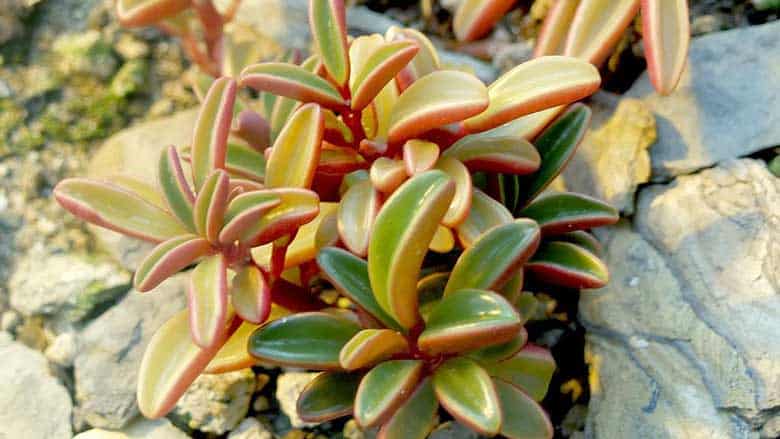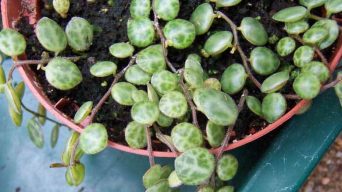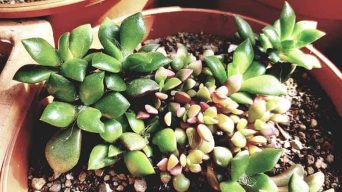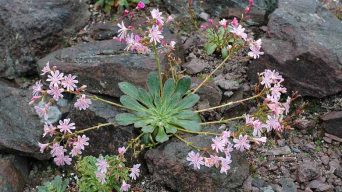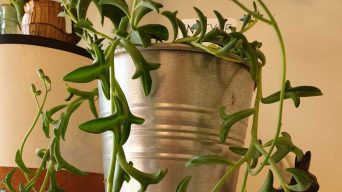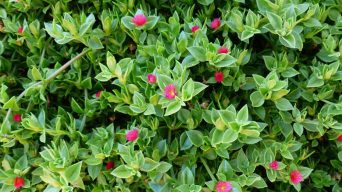If you’re looking for a succulent that’s easy to care for and propagate, then Peperomia Graveolens is perfect.
This plant has become quite popular lately due to its unique form and wide availability.
This guide will give you all the information you need about how to take care of your Peperomia graveolens plants and how to propagate them!
Peperomia Graveolens ‘Ruby Glow’ Description
Peperomia graveolens ‘Ruby Glow’ is a succulent plant that originates from the tropical regions of Central and South America.
It is a succulent with rosettes of fleshy, waxy leaves. It has dark green leaves with rippled edges, pinkish-red markings on the leaf margins, light green on the top, and dark red undersides.
The leaves emit a strong scent, often described as “peppery.”
Peperomia graveolens ‘Ruby Glow’ can grow into a small tree up to 18 inches tall.
They are also known for their ability to grow in low light and with little water, making them ideal houseplants or indoor plants.
Peperomia Graveolens is an easy to grow plant that adapts well to different environments, from full sun, partial shade, or indoors with bright light.
The plant will thrive without much care from the owner. This makes them great for novice gardeners looking to add color to their homes.
How To Care for Peperomia Graveolens ‘Ruby Glow’
A well-cared-for Peperomia graveolens can last up to six months in any pot before repotting.
This means they are perfect houseplants since they don’t need much water or light exposure to thrive.
You’ll see below how simple it is to have one on display all year round!
Sun Exposure & Light Requirements
It is important to know that the Peperomia Graveolens plant will need more sun exposure than it would naturally get in its native environment.
This means you will likely have to move this succulent around a bit so that it can receive enough light and maintain good health.
For your Peperomia graveolens plants to flourish, they should be given at least six hours of direct sunlight each day or placed near a sunny window where there’s plenty of bright indirect light, if not all day long.
You might want to consider using artificial lights during periods when natural light isn’t available outside, such as the winter months.
If you use any artificial light-whether it’s fluorescent bulbs around the house or LED grow lights in an indoor garden. You’ll need to provide additional humidity and water for these succulents so their leaves don’t start drying out and turning brown.
This is because most artificial lights produce much more light than heat, which is essential for succulent growth and survival.
Some recommend misting the plants with a spray bottle every day. Still, others prefer to give them a thorough water soaking once per week to maintain sufficient humidity levels.
Watering
Watering is not an issue for Peperomia Graveolens. It gives it time to dry off before watering.
You can water the plant every few days, wait until a week has passed, and then give it enough water to last two weeks.
The soil should be damp but never soggy wet, so do not overwater, as this will cause root rot.
Let the soil dry out between watering, and then keep it moist for a week.
The frequency of watering your Peperomia graveolens is dependent on the plant’s environment.
If there has been a lot of rain or if it is in high humidity, you may find that the leaves start to brown and wilt.
In this case, water more frequently and try to move it into a drier environment.
Finally, if you see browning leaves with no other disease symptoms or pests present on the plant, watering less often may be all that is needed.
Temperature and Humidity
Peperomia Graveolens plants are native to the rainforest and need a relatively humid environment.
The plant does not tolerate cool air very well and will turn brown if exposed to low temperatures.
It is best for them to maintain healthy leaves with good coloration when kept between 60-75 degrees Fahrenheit. However, this can be difficult because the temperature has such an extreme range during different seasons.
The humidity level should ideally stay around 50 percent or higher at all times. Still, anything over 70% can cause diseases like Botrytis cinerea, peperomia blight, and excessive algae growth.
Misting is an excellent way to maintain the humidity level at around 50-60%. Still, it should only be done in the morning or right before sunset.
Some people use room humidifiers to keep the humidity level high, but it’s important not to make it too wet.
It should just be enough that a small amount of water droplets can be seen on certain parts of the Peperomia plant leaves.
When you try this out for yourself and notice any mold or algae growth, clean up with hydrogen peroxide and wash everything down thoroughly before introducing new air in the space.
Soil Requirements
Peperomia Graveolens is a unique plant that is in the Peperomia genus. This means it has specific soil requirements and needs to be watered in certain ways. Still, if you follow these guidelines carefully, your Peperomia will thrive.
The first thing you need to know about this succulent’s soil requirement is that it requires a well-draining potting mix with some sand. This allows water to flow freely without stagnating on the surface.
The Peperomia Graveolens plant prefers sandy soil with no more than about 15% organic material.
In nature, you can find this type of peaty soil in areas that have been sheltered from the sun for long periods during their evolution.
A good potting mix has plenty of perlite and pumice added to allow air and water movement through the medium.
To create the perfect potting mix, combine equal parts sand or grit, sharp garden loam (or manure), and composted bark chippings before adding any fertilizer.
Fertilizing
Peperomia graveolens is a type of succulent plant that thrives in well-drained soil.
Fertilizing peperomias with nitrogen will help your succulents grow faster and maintain an attractive green color. Still, too much can cause the peperomia to become leggy or lead to fungal diseases.
Some best practices for fertilizing your Peperomia graveolens are:
Don’t use a fertilizer designed for fruiting vegetables in a vegetable garden because this type contains high phosphorus levels, which is unsuitable for herbaceous perennials like Peperomia Graveolens.
- Slow-release organic nutrients are better than quick-release chemical ones. They provide lower amounts over time so that you won’t have any problems with over-feeding with nutrients.
- Feed every two weeks during the summer and once a month in winter, when light levels are lower, affecting plant growth.
- Use a fertilizer designed for succulents and cacti, like a 20-20-20 blend, with an NPK ratio of 11:11:12.
Potting and Repotting
Peperomia Graveolens are succulents and, therefore, naturally require repotting. Repotting your plant is necessary for the following reasons:
- To provide more space in the pot as it grows larger.
- If roots start poking out of drainage holes.
- Remove old soil, which can disrupt a healthy root system, leading to less water retention and fewer nutrients from being absorbed by the plant’s roots.
To avoid these problems, when transplanting them into new pots or containers, ensure you have enough room between the top of the root ball and the bottom of its container.
You should also thoroughly clean any other surfaces where Peperomia Graveolens will be placed to avoid any buildup of bacteria and fungi.
When you must repot your Peperomia, make sure you choose a clay pot with good drainage holes at the bottom.
Fill up this new pot with soil mixed 50% by volume (or weight) in equal parts peat moss and perlite.
Mix thoroughly before filling half of the container’s depth by planting your little succulent in there!
Repeat this process until you have filled all available space between plants. Remember not to overfill containers because they need good drainage and airflow.
The Peperomia Graveolens likes a bright location, but the sun should not directly hit it because they can be sensitive to high temperatures!
Bring your succulent out of direct sunlight when you start feeling that it has been exposed for too long or if you notice any problems with its leaves turning brown.
Pruning
Pruning Peperomia graveolens plants is not absolutely necessary for these succulents.
However, if you want to maintain a fuller and bushier look with your plant, it may be advisable to prune the stems back occasionally to control its growth habits.
This will also encourage new shoots from within the stem or at the base of the leaf nodes, eventually forming new branches.
- It’s best not to cut off more than one-third of any stem (if there are multiple stems) because this could weaken and stunt further development on that branch or stem.
- Remove leaves along with their attached stalks below soil level when they turn brown around mid-autumn, which encourages fresh new growth.
- Crushing or cutting back the leggy stems also encourages new branching and will save more leaves from being lost to pests.
Pests and Diseases
Peperomia Graveolens succulents are not susceptible to many common plant diseases.
The most severe issue is spider mites, which can be dealt with using insecticides or soap and water when infestations reach a certain threshold.
You should also check for pests like aphids by looking under the leaves. Treat any found insects immediately before an infestation worsens.
Pests will thrive if the conditions are too humid. Still, you can avoid this problem by opening up windows periodically throughout the day.
Ensure there isn’t stagnant water sitting around anywhere near the plant and that the water you provide is filtered.
Peperomia Graveolens can also develop chlorosis, which looks like yellowing leaves. This is a problem if the soil isn’t draining well or gets too dry.
It will be solved by repotting and using a different potting mix.
Make sure to drain any excess water away from the plant’s base at least once every other day so it doesn’t get soggy for long periods.
If your Peperomia Graveolens succulent develops black spots on its leaves, this means they are getting too much sun exposure (or direct contact with heat).
Move them into an area where there is less light to avoid scorching damage that could eventually kill the plant!
How To Propagate Peperomia Graveolens ‘Ruby Glow’
You can propagate Peperomia Graveolens by using a cutting from an existing plant.
You can also take seeds and germinate them in a seeding mix before planting them into the soil to grow new plants.
Cuttings are easier because they don’t need special care after being taken off the parent plant–stick it in some dirt!
Stem Cutting
To propagate a Peperomia Graveolens using stem cuttings, you have to follow the following steps:
- Take a cutting from the plant using clean, sharp pruning shears or scissors.
- Make sure the cutting is at least a few inches long and has at least one leaf on it.
- The end of the stem you cut should be dry with no fresh sap.
- Put your cutting into moist soil. Ensure the roots are covered with dirt, leaving an inch or two sticking out.
- Keep the soil moist but not wet for a few days to help the cutting start rooting.
- In about two weeks, you should notice signs of new growth emerging from your cutting, and it will be ready to transplant!
Seeds
To propagate by taking seeds:
- Take fresh seed pods off mature plants with clean hands and dry them thoroughly on newspaper for two days before planting them outdoors.
- Plant five inches deep outside during the fall or winter months. Germination will occur over the next few weeks as weather conditions are right when planted. Then hold over until spring–make sure not to water at any point in this process.
- When spring arrives, your new plants will emerge, and they should start to grow quickly.
Is The Peperomia Graveolens Toxic?
The Peperomia Graveolens plant is not toxic to people. However, it might cause irritation in some individuals that are allergic.
The sap may also be mildly irritating to sensitive skin.
If touched or ingested, the Peperomias can induce some mild stomach upset and diarrhea if eaten in significant quantities by animals or humans.
Final Thoughts
Peperomia Graveolens is a popular succulent that can thrive in various environments.
It is a very easy to propagate and care for succulent plant.
They are an excellent plant for decoration, so if you’re looking for an indoor or outdoor decorative addition, this Peperomia variety can be perfect!

